Building on the Open Curriculum
The ability to pursue a self-directed project is irresistible to Brown students, many of whom arrive on campus with multiple interests and seek to take advantage of the University’s Open Curriculum.
“When we ask students about the most impactful elements of their Brown education, they mention three things: creating knowledge in partnership with faculty, sharing knowledge in close collaboration with their peers, and applying knowledge in service to communities around the world,” says Dean of the College Rashid Zia ’01. “The Royce Fellowship allows them to do all three.”
jesús hernández '03, associate director of engaged scholarship at Brown’s Swearer Center for Public Service and director of the Royce Fellowship Program, stresses that students feel supported, but not directed, in their endeavors. Crucially, there is no pressure to specifically produce an academic text at the end of their project.
“We have an expansive view about what research is and what the end goals or end products of research can be,” he says. “Sometimes Royce Fellows produce a chapter of their senior thesis. But, sometimes the result is a one-woman show or a community health survey. The key is that the projects have some sort of public purpose or create some sort of public good.”
Jasmine Beach-Ferrara ’98, who was a member of the first cohort of Royce Fellows, came to Brown through the Program in Liberal Medical Education, which combines undergraduate education and professional studies in medicine into a single eight-year program. Her interests spanned creative writing, hospice care, processing grief and loss, and LGBTQ issues.
Her fellowship project, working with University Chaplain Janet Cooper-Nelson, provided her with the time, the resources, and the guidance she needed to explore the intersections among those topics.
“You don't always understand in the moment how different pieces of your life connect,” says Beach-Ferrara. “Looking back now, I understand how the experience I had as an undergraduate at Brown — the academic work, the relationships, the service work, and the fellowship — created a foundation that has allowed me to pursue my dreams.”
Beach-Ferrara chose not to attend medical school in order to pursue an MFA in fiction writing. She wrote a book of short stories that grew out of her Royce project and completed a Master’s of Divinity at Harvard. In addition to serving as an ordained minister, she currently directs the nonprofit Campaign for Southern Equality that works for LGBTQ equality and is running for Congress in Western North Carolina.
“All of these things are directly connected to what I did during my Royce Fellowship,” she says.
